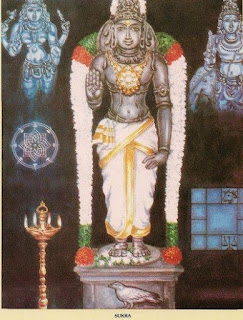Vivekachudamani 19
adau nityanitya vastu vivekah parigaõyate |
iha mutra phala bhoga vira gastadanantaram |
sama disat kasam pattir mumuksutvamiti sphutam ||
(Sankaracarya's Vivekachudamani 19)
While enumerating the qualifications), first we count the ability to discriminate between the Real and the unreal; next comes a spirit of detachment from the enjoyment of the fruits of actions here and hereafter; after that is the groups of six virtues beginning with calmness, and the last is undoubtedly an intense desire for liberation.
In Śrīmad-Bhāgavatam [1.1.1] it is said, yatra tri-sargo ’mṛṣā: “This material world is illusory.” We have all seen a pretty mannequin of a girl in a shopkeeper’s showcase. Every sane man knows that it is an imitation. But the so-called beautiful things in this material world are just like the beautiful “girl” in the shopkeeper’s window. Indeed, whatever beautiful thing we see here in this material world is simply an imitation of the real beauty in the spiritual world. As Śrīdhara Svāmī says, yat satyatayā mithyā sargo ’pi satyavat pratīyate: “The spiritual world is real, and the unreal, material manifestation only appears real.” Something is real only if it will exist eternally. Reality cannot be vanquished. Similarly, real pleasure must be eternal. Since material pleasure is temporary, it is not actual, and those who seek real pleasure don’t take part in this shadow pleasure. They strive for the real, eternal pleasure of understanding the Supreme Lord.
Now, if we are at all interested in reaching liberation, then we must practice bhakti-yoga. The word bhakti means “devotional service,” or, in other words, submission to the Supreme Lord. Kṛṣṇa clearly says in Bhagavad Gita, puruṣaḥ sa paraḥ pārtha bhaktyā labhyas tv ananyayā. The words tv ananyayā here mean “without any other engagement.” So, to reach the spiritual abode of the Lord, we must engage in pure devotional service to Paranthama.
iha mutra phala bhoga vira gastadanantaram |
sama disat kasam pattir mumuksutvamiti sphutam ||
(Sankaracarya's Vivekachudamani 19)
While enumerating the qualifications), first we count the ability to discriminate between the Real and the unreal; next comes a spirit of detachment from the enjoyment of the fruits of actions here and hereafter; after that is the groups of six virtues beginning with calmness, and the last is undoubtedly an intense desire for liberation.
In Śrīmad-Bhāgavatam [1.1.1] it is said, yatra tri-sargo ’mṛṣā: “This material world is illusory.” We have all seen a pretty mannequin of a girl in a shopkeeper’s showcase. Every sane man knows that it is an imitation. But the so-called beautiful things in this material world are just like the beautiful “girl” in the shopkeeper’s window. Indeed, whatever beautiful thing we see here in this material world is simply an imitation of the real beauty in the spiritual world. As Śrīdhara Svāmī says, yat satyatayā mithyā sargo ’pi satyavat pratīyate: “The spiritual world is real, and the unreal, material manifestation only appears real.” Something is real only if it will exist eternally. Reality cannot be vanquished. Similarly, real pleasure must be eternal. Since material pleasure is temporary, it is not actual, and those who seek real pleasure don’t take part in this shadow pleasure. They strive for the real, eternal pleasure of understanding the Supreme Lord.
Now, if we are at all interested in reaching liberation, then we must practice bhakti-yoga. The word bhakti means “devotional service,” or, in other words, submission to the Supreme Lord. Kṛṣṇa clearly says in Bhagavad Gita, puruṣaḥ sa paraḥ pārtha bhaktyā labhyas tv ananyayā. The words tv ananyayā here mean “without any other engagement.” So, to reach the spiritual abode of the Lord, we must engage in pure devotional service to Paranthama.



Comments
Post a Comment